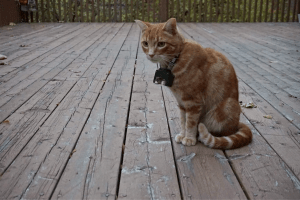
Outdoor cats a threat to more than just birds
By: Marilyn Sheen and Anna McMenemy
Letting your cat outside might seem like harmless fun and good exercise for the animal, but it actually poses a serious risk to wildlife.
Cats kill an estimated 2.5 billion birds every year, making them one of the leading causes of bird mortality. But it’s not just birds. Cats also prey on insects like butterflies and moths as well as small mammals during their outdoor excursions, and in turn, disturb the area’s biodiversity.
University of Guelph professor and ecologist, Dr. Ryan Norris, is immersed in this issue. Norris and his research team are leading studies on the subject in hopes of quantifying the damage done by outdoor cats.
“It’s really important that we get a handle on the specifics of this problem,” says Norris, “because if we lose biodiversity, we’re going to be in big trouble.”
Norris and his team, including Dr. Elizabeth Gow, a research scientist at Environment and Climate Change Canada and MSc student Marlee Pyott, are conducting a ground-breaking study that follows cats directly to determine specifics like how much and what species cats hunt during the day compared to at night and how their hunting behaviours change across seasons. It will be the first study to track cats year-round.
After a callout this past spring for feline participants in the Kitchener-Waterloo/Guelph/Cambridge area Norris’s team received over 500 interested applicants. With only 20 cameras available, they chose the most suitable cats for the job – ones that are frequently let out at all times of the day and used to wearing a collar. Data collection has been underway since May and Norris expects it to continue for at least a year.

To follow the cats as closely as possible, the team has partnered with local technology specialist, Brett Forsyth, to develop small, light-weight cameras that attach to cats’ collars and record their activity (photo, left, courtesy of Dr. Ryan Norris). The cameras, which are motion-activated and equipped with infrared lights and GPS, will allow Norris and his team to see how far cats travel from home, what types of prey they hunt, how many insects and animals they kill, and the risks to which they expose themselves.
To help evaluate the impact of outdoor exposure on cats and their owners, Norris is collaborating with Dr. Lee Niel from the Ontario Veterinary College. Niel is studying how the outdoor behaviour of cats influences their overall health and their relationship with their owners.
It’s a holistic approach to the issue, says Norris. While the primary focus is on wildlife conservation, the research team recognizes how important it is to consider the cat’s health and environment. Embodying principles of One Health – that is, the recognition that human, animal and environmental health are interconnected – this project accounts for multiple factors. It recognizes that cats impact wildlife populations and ecosystems while also accounting for the cat’s health and wellbeing. And with cats being a companion animal, their health and activity often affects their owner’s wellbeing and many people stand by letting their cats outside.
Norris hopes that the results from this work will inform owners of the risks at play – to their cats and to wildlife – in letting their cat outside. It will also have implications for policymakers, informing mitigation strategies and policies to reduce the biodiversity loss caused by cats. This research will offer insight as to when or even if cats should be let outside.
“If we can find a strategy to manage the time spent outdoors by cats that takes into account wildlife impact, as well as the health of the cats, then I think we’ve made some serious progress,” Norris says.
Norris’s work is funded by the Guelph Institute for Environmental Research, the Kenneth M. Molson Foundation, and the Natural Sciences and Engineering Research Council of Canada. Read more about Norris and his research on his lab’s website: https://norrislab.ca/



